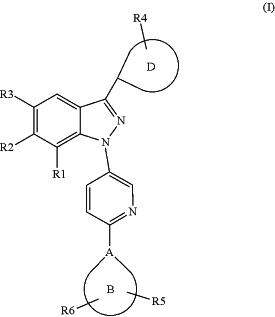| CPC C07D 401/14 (2013.01) [A61K 45/06 (2013.01)] | 40 Claims |
|
1. A compound of formula (I)
 Wherein
A is N or C,
B is a group selected from among the group consisting of
a 5-7-membered monocyclic heterocyclyl containing 1 or 2 N-atoms,
a 6-membered bicyclic heterocyclyl containing 1 N-atom,
a 7-11 membered bicyclic heterocyclyl containing 2 N-atoms,
a 7-membered bicyclic heterocyclyl containing 1 N-atom and 1 O-atom,
a 6-membered monocyclic heterocyclyl containing 1 N-atom and 1 heteroatom selected from the group consisting of O and S,
a 9-membered bicyclic heterocyclyl containing 3 heteroatoms, 2 of which are N and the other is O,
a 9-membered bicyclic heterocyclyl containing 1 N-atom and 1 S-atom,
a 10-membered bicyclic heterocyclyl containing 3 N-atoms, 2 of which are substituted with C1-6-alkyl,
phenyl,
a 9-membered bicyclic heteroaryl containing 3 N-atoms,
—C1-4-alkylene-pyrimidine, and
—C1-4-alkylene-O—C1-3-alkyl;
D is a group selected from among the group consisting of
a 9-membered bicyclic heteroaryl containing 2 N-atoms,
a 10-membered bicyclic heteroaryl containing 1 N-atom, and benzodioxole;
R1 is selected from among the group consisting of —H, —C1-6-alkyl, —CF3, —C2-6-alkynyl, —O—C1-6-alkyl and halogen;
R2 is selected from among the group consisting of —H, —C1-6-alkyl, —C1-6-alkylene-OH, —C(O)OH, —C(O)O—C1-6-alkyl and -pyrazolyl-C1-6-alkyl;
R3 is —H or —C1-6-alkyl;
R4 is selected from among the group consisting of —H, —C1-3-alkyl, —NH2, —NHC1-3-alkyl and N(C1-3-alkyl)2;
R5 is absent or is selected from among the group consisting of —H, —C1-6-alkyl, —S(O2)—C1-6-alkyl, —NH—S(O2)—C1-6-alkyl, ═O, —C(O)—C1-6-alkyl, —C(O)H, —C(O)OH, —C(O)NH2, —C(O)O—C1-6-alkyl, —NR5.1R5.2, —C1-6-alkylene-C(O)OH, —S(O2)—NH2, -pyrolidin-2-one-1-yl, -tetrazolyl, and a 5-membered heteroaryl with 1 or 2 heteroatoms selected from the group consisting of N and O, substituted with R5.3;
R5.1 is selected from among the group consisting of —H, —C1-6-alkyl, —C(O)—C1-6-alkyl and —C1-6-alkylene-O—C1-6-alkyl;
R5.2 is selected from among the group consisting of —H, —C1-6-alkyl, —C(O)—C1-6-alkyl, —C1-6-alkylene-O—C1-6-alkyl and —C1-6-alkylene-R5.3;
R5.3 is selected from among the group consisting of —H, —C1-6-alkyl and a 6-membered heteroaryl with 1 or 2 heteroatoms selected from a group consisting of N and O;
R6 is absent or is selected from among the group consisting of —H, —C1-6-alkyl, ═O and —C(O)OH;
or a salt thereof.
|